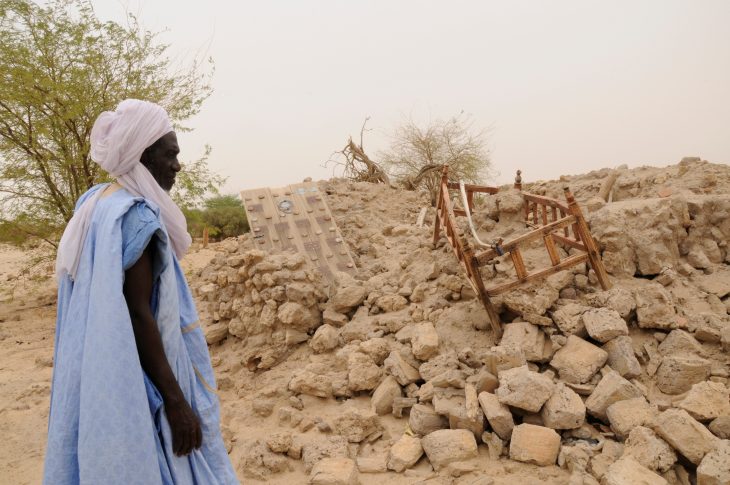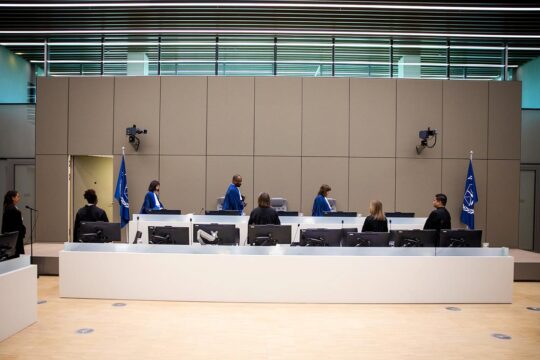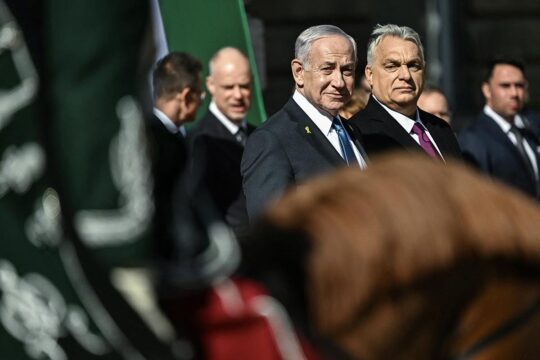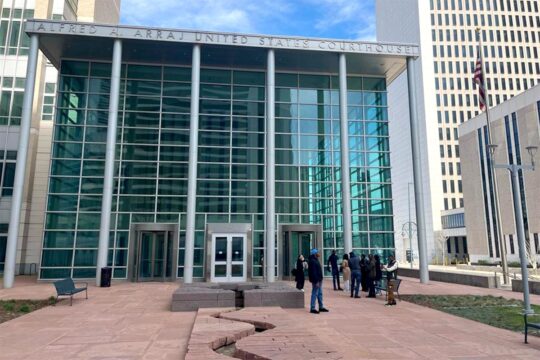The trial of Ahmed Al Faqi Al Mahdi, known as Abu Tourab, is to open on Monday August 22 at the International Criminal Court (ICC). This Ansar Dine militiaman was head of the Islamic morality brigade during the occupation of Timbuktu, northern Mali, from April 2012 to January 2013. He is accused of war crimes for the destruction of nine mausoleums in the “City of 333 Saints” and the entrance to the Sidi Yahia mosque. Al Mahdi has said he will plead guilty. The ICC Prosecutor has limited the charges to destruction of cultural property, giving the case symbolic significance. Marc-André Renold, Director of the Art-Law Centre at the University of Geneva, here talks to JusticeInfo about the importance of this trial.
JusticeInfo: Why do you think this trial is important?
Professor Marc-André Renold: It is the first case where the charge is intentional destruction of cultural property. There have been other cases where the charges included destruction of cultural heritage, notably attempts to destroy the old town of Dubrovnik in former Yugoslavia. The destruction of cultural heritage was taken into account in the trial but it was just one aspect among others, whereas it is at the heart of this trial. And it is not because we are focusing on something other than human lives than it is not important. I really think it goes together. And up to now these international trials have not focused on the destruction of cultural heritage.
JusticeInfo: UNESCO Director-General Irina Bokova has called the destruction of cultural heritage “cultural genocide”. What do you think about that?
MAR: It is a strong term which reflects the importance of the link between the material and immaterial aspects of things and of cultural property. For a long time, we talked mainly about the material aspect. I am thinking, for example, about the destruction of monuments and theft of artworks during the Second World War. But more recently UNESCO and others have become interested in the immaterial aspect of cultural heritage and I think it has basically become very important. There is a 2003 Convention for the Safeguarding of the Intangible Cultural Heritage. But what we are seeing with these destructions is that they target the immaterial aspect, relating to religion, history and tradition. And the term “cultural genocide” shows we can not only destroy the physical property but also the culture, wipe out the enemy through all that his culture may represent. UNESCO recently initiated a new debate: Should we, or should we not invoke the Responsibility to Protect in the cultural domain? It is a new idea which came up some ten years ago and which is linked notably to the prevention of genocide. It aims to provide that the State in which such acts occur and the international community can intervene to prevent the threat of genocide. So we asked ourselves “Isn’t the destruction of cultural heritage a preparatory act for genocide which could justify intervention?” We realize that these attacks on culture can perhaps be warning signs that we should study more closely.
JusticeInfo: According to the Prosecution, the monuments were destroyed after deliberation by the Islamic tribunal set up during the occupation of Timbuktu from April 2012 to January 2013. Don’t you think that here we have two different concepts of law, two different visions of the world?
MAR: There are often different visions in conflict. But what we should note is a desire in the international community today to protect cultural heritage as part of the fundamental values of a society. There is respect for it which is due and which is recognized, including in Mali and Syria. These Conventions can be used more or less universally. We are nevertheless talking about basic rules of international society, and even if we disagree with them, that cannot justify destruction.
JusticeInfo: Who are the victims of destruction of cultural heritage?
MAR: It is first and foremost the local community, the people who can no longer enjoy this cultural heritage to perform traditional and religious acts. It is clearly also the international community, but I think it is important not to forget that these places are important for the local community. We see this in the way local communities react to protect them. We know what Malians did to protect the manuscripts [during occupation of Timbuktu by Jihadist groups nearly 400,000 manuscripts were discreetly evacuated by the inhabitants to keep them safe]. It wasn’t the international community that acted, it arrived too late. We also remember the human chain that formed around the museum in Cairo in early 2011, when people thought it would be attacked. Whether it is Timbuktu or elsewhere, local communities are steeped in this heritage. It is a very important aspect which shows culture is not just something the big Western powers think is important but also the people in the places concerned. Of course, this is the International Criminal Court, it is a certain vision of justice, but I think attacks on cultural heritage are attacks that hurt local communities a lot. And when it comes to reconstruction, culture, religion, music and art can help reconciliation.
JusticeInfo: We have seen recently in Iraq and Syria that cultural heritage is also the target of looting. Do we have a way to stop this?
MAR: Yes, cultural property can be not only destroyed but also used to fund terrorism. With regard to Syria and Iraq, there are UN Security Council Resolutions that affirm that. Rules have been adopted by many countries, art market countries like France, the UK, US and Switzerland. The Hague Convention of 1954, which is often referred to for basic rules on the protection of cultural heritage in armed conflicts, has a Protocol which provides that States should commit to conserving and returning after the conflict objects that are at risk of looting. There are also what we call “safe havens” for cultural wealth. Some States have adopted legislation that allows this. Switzerland is the first country to have done so. There is a “haven” in the German speaking part of Switzerland. It is a former munitions depot which is now designated to take in cultural objects if this should be necessary. Nevertheless, it is a very complicated issue. Wouldn’t it be a form of neo-colonialism to say to a Syrian “you can’t protect your cultural heritage so we will do it”? It is also very costly, but the aim is precisely to avoid looting. There is a little precedent, which is very interesting. Near Basel some individuals set up a museum for endangered Afghan cultural property. It existed for about ten years. More than a museum, it was a kind of sanctuary, and when the situation improved in Afghanistan all the contents were returned to Kabul museum under the auspices of UNESCO.
JusticeInfo: Do you think protection of cultural property can help peace?
MAR: It allows everyone to speak more or less the same language. Cultural heritage should bring people together rather than tearing them apart. In a conflict-affected society, cultural heritage can help reconciliation, I am absolutely convinced of that. Cultural heritage carries a very strong symbolic value.






